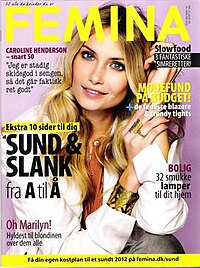Femina is a Danish language weekly magazine for women published by Aller Media in Copenhagen, Denmark. The magazine also has a Swedish edition.
 | |
| Editor | Camilla Lindemann |
|---|---|
| Categories | Female |
| Frequency | Weekly |
| Publisher | Aller Press AS |
| Total circulation (2024) | 25,000 (Denmark) |
| Founded | 1874 (as a fashion journal) 1952 (as a women's magazine) |
| Company | Aller Media |
| Country | Denmark |
| Based in | Copenhagen |
| Language | Danish |
| Website | www |
| ISSN | 0014-9853 |
History and profile
editFemina began in its current form in 1952 and is a continuation of illustrated fashion journal Nordisk Mønster Tidende (1874–1952),[1] making it the oldest weekly magazine in Denmark.
Femina is part of Aller Media and is published by Aller Press AS.[2] The magazine has its headquarters in Copenhagen.[3] Camilla Lindemann has been editor since March 2005.[4] It positions itself towards modern women and covers fashion, food, interior design, health and beauty, psychology and culture. A Swedish edition is also produced.[4]
The 29 July 1903 edition caused a scandal when it printed "bh" as an abbreviation of "brystholder" (brassiere) for the first time.[5]
During the late 1950s, Femina featured articles on women's sport and introduced its readers to both traditional and lesser known sports.[6] In October 1959, the magazine gave its name to BK Femina, a women's football club from Slagelse.[6] They supplied kit and boots for the players and provided sponsorship and coverage to the team which became unofficial World Champions in 1970.[6][7]
Circulation
editIn 2001, the magazine had a circulation of 87,000 copies in Denmark.[8] The circulation of the Danish version of Femina was 89,680 copies during the second half of 2003[9] and 90,000 copies for 2003 as a whole.[10] The circulation of the magazine was 52,000 copies in 2006.[2] It rose to 68,900 copies during the last six months of 2007.[11]
In the second half of 2011, Femina had an average circulation of 54,117 copies per issue.[12] In 2013, the magazine had a circulation of 50,000 copies in Denmark.[13] In 2018, the circulation was down to 38,000 copies in Denmark.
See also
editReferences
edit- ^ "Carl Allers Etablissement A/S". Reference for Business. Retrieved 23 March 2015.
- ^ a b "Top ten titles by circulation/issue 2006". Nordicom. Archived from the original on 8 March 2016. Retrieved 28 February 2015.
- ^ Europa World Year. Taylor & Francis. 2004. p. 1439. ISBN 978-1-85743-254-1. Retrieved 21 April 2015.
- ^ a b Karen Margrethe Schelin (5 December 2004). "Damernes diva". Berlingske (in Danish). Archived from the original on 23 September 2015. Retrieved 14 July 2012.
- ^ Louise Christensen (29 July 2003). "Tillykke og een skål ...". MetroXpress (in Danish).
- ^ a b c Anne Brus; Else Trangbæk (2003). "Asserting the right to play – women's football in Denmark". Soccer & Society. 4 (2–3): 95–111. doi:10.1080/14660970512331390855. S2CID 143684174.
- ^ Fan & Mangan 2003, p. 104
- ^ "Statistical Yearbook 2002". Denmarks Statistik. p. 157. Retrieved 9 May 2016.
- ^ Erik Stener Jørgensen; Allan Lillelund (10 February 2004). "Kontrollerede oplagstal (1. half of 2009) - Femina". Dansk Oplagskontrol (in Danish). Archived from the original on 23 September 2015. Retrieved 14 July 2012.
- ^ Mike Friedrichsen; Astrid Kurad (23 May 2007). "The Magazine Market in Denmark and Germany". All Academic. Archived from the original (Conference Paper) on 2 April 2015. Retrieved 28 February 2015.
- ^ Eva Harrie (2009). "The Nordic Media Market" (PDF). Nordicom, University of Gothenburg. Göteborg. Retrieved 23 April 2015.
- ^ Erik Steiner; Thomas Jermlin (24 February 2012). "Kontrollerede oplagstal (1. half of 2009) - Femina". Dansk Oplagskontrol (in Danish). Archived from the original on 23 September 2015. Retrieved 14 July 2012.
- ^ "Consumer-paid magazines by circulation". StatBank Denmark. Retrieved 28 February 2015.
Bibliography
edit- Fan, Hong; Mangan, J. A. (2003). "Women's Football in Denmark". Soccer, Women, Sexual Liberation: Kicking Off a New Era. Routledge. ISBN 978-0714684086.